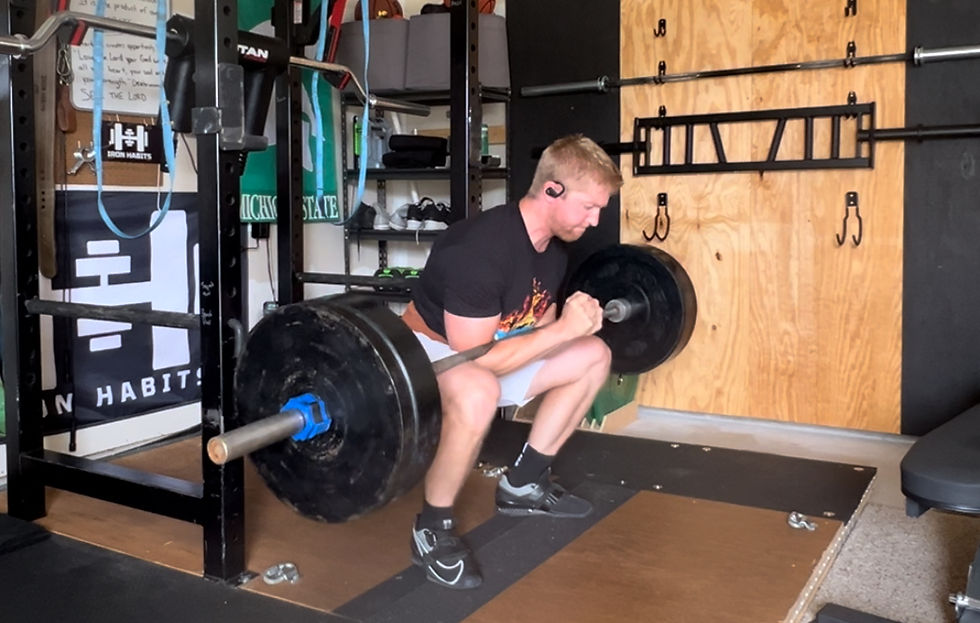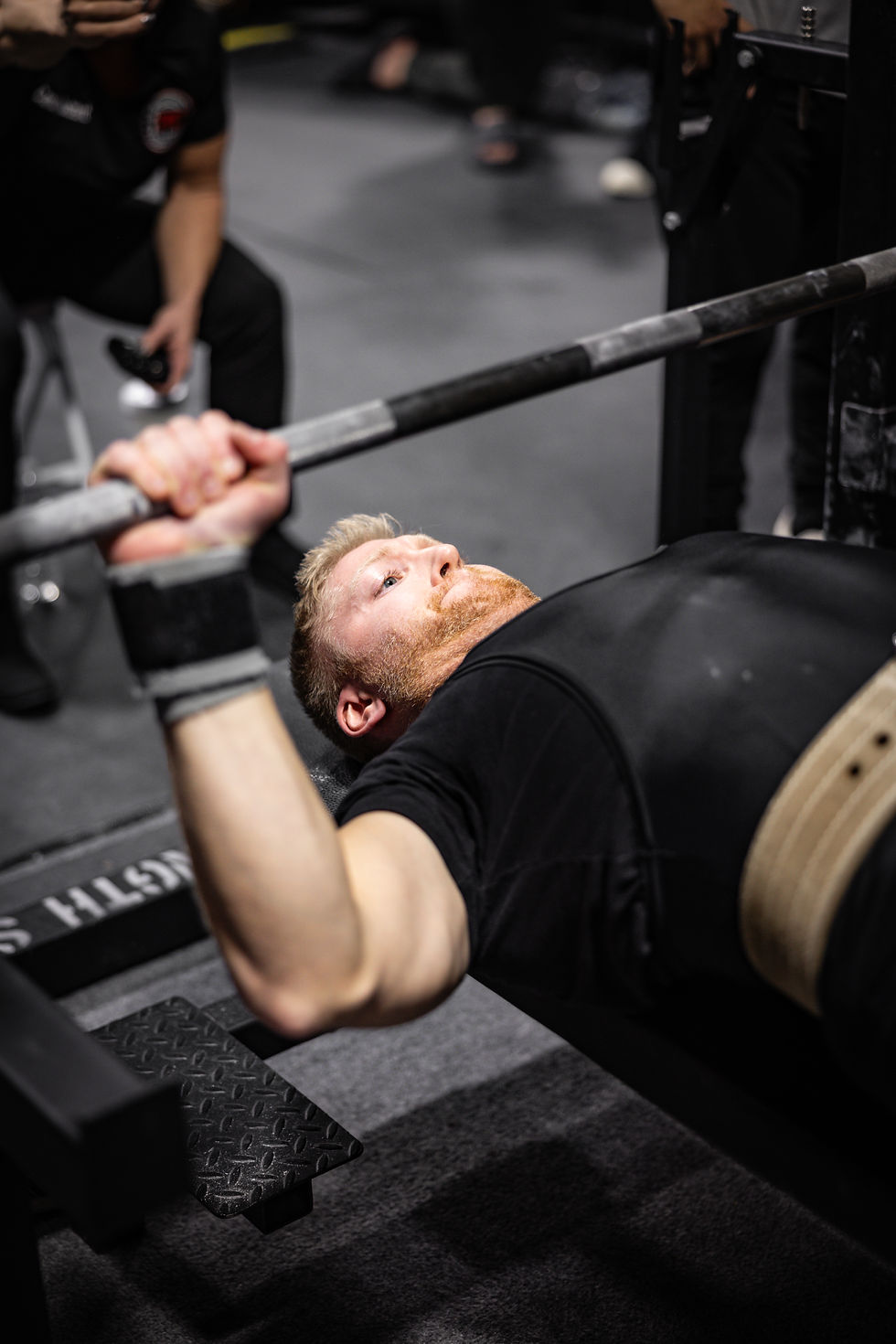Starting Strength Rejects, Part 2: Exploring Strength development Using Non-Traditional Exercises
- Jordan Van Dyk

- Mar 3
- 5 min read
Updated: Apr 15
If you haven’t already checked out the first installment of this article on Instagram, I recommend doing so before reading further.
Once you move beyond the novice phase of strength training, programming becomes more of an art. Many lifters work through Practical Programming and build impressive strength, but eventually find themselves craving variety to break up the monotony of barbell training.
The reality is, there are countless ways to apply stress to your body and continue getting stronger. With thousands of articles on intermediate programming scattered across the internet—often with conflicting opinions—it’s easy to get lost in the options.
This article explores how to incorporate less conventional movements while staying "true enough" to the core principles of Starting Strength and traditional succeeding intermediate programs. It’s written for barbell enthusiasts who want to expand their training repertoire without straying too far from the methodology that got them strong in the first place.

In part one, I discussed the following movements:
The Push Press
Zercher variations (Squat and deadlift mainly)
The Hatfield Squat
Bulgarian Split Squats
Trap Bar Deadlifts
In part two, I've also added
Seal Rows
Belt Squats
Phase: Texas Method (Classic Intermediate Progression)
This method alternates Volume, Light, and Intensity Days to drive strength gains.
Monday – Volume Day
Squat 5x5 @ 80-85%
Bench/Press 5x5
Zercher Squats 3x5 (Replaces Front Squats for upper back & core engagement)
Seal Rows 4x8 (Instead of Barbell Rows for stricter back work)
Wednesday – Light/Recovery Day
Hatfield Squats 3x8 (Easier on the lower back but still allows good leg volume)
Press/Bench 3x5 (alternate)
Belt Squat 3x12 (For quad growth without spinal fatigue)
Chin-Ups 3x10
Friday – Intensity Day
Squat 1x5 @ PR weight
Bench/Press 1x5 @ PR weight
Deadlift 1x5 @ PR weight
Snatch-Grip Deadlift 3x5 (Replaces speed pulls for more upper-back development)
Weighted Dips 3x8 (For pressing strength and chest development)
Phase: Heavy-Light-Medium (Another Intermediate Approach)
A flexible alternative to Texas Method that works well for older lifters or those needing more recovery.
Monday – Heavy Day
Squat 3-5x5 @ 85%
Bench/Press 3-5x5 @ 85%
Zercher Squats 3x5
Seal Rows 4x8
Wednesday – Light Day
Hatfield Squats 3x8
Press/Bench 3x5 @ 75%
Belt Squats 3x12
Chin-Ups 3xAMRAP
Friday – Medium Day
Squat 3x5 @ 80%
Bench/Press 3x5 @ 80%
Snatch-Grip Deadlift 3x5
Weighted Dips 3x8
Why This Works for Intermediate Lifters
Keeps the SS core lifts as primary strength drivers.
Introduces alternative exercises without disrupting overload tracking.
Addresses weaknesses (upper back, quads, core, pressing) without excessive fatigue.
Allows continued linear progression in an intermediate framework.
Other ways to think about it: Weak Points & Strength Exercises
1. Squat Weak Points
Weak out of the hole (bottom position)
Cause: Poor quad & glute strength, lack of depth control
Solution:
Zercher Squats (3x5) – Forces a deeper squat and builds core strength.
Bulgarian Split Squats (3x8 per leg) – Strengthens unilateral leg drive.
Paused Squats (3x5) – Improves control and tension at the bottom.
Weak mid-range (grinding through the middle of the squat)
Cause: Weak posterior chain or poor bar speed
Solution:
Hatfield Squats (3x8) – Allows more weight while reinforcing proper bar path.
Snatch-Grip Deadlifts (3x5) – Strengthens upper back & hamstrings to stabilize squat mechanics.
Box Squats (3x5) – Builds explosive strength out of the bottom.
Weak at lockout (standing up from the sticking point)
Cause: Poor hip drive, weak glutes, or inefficient bar path
Solution:
Belt Squats (3x12) – Develops quads and glutes without spinal fatigue.
Good Mornings (3x8) – Strengthens hip extension and posterior chain.
Bulgarian Split Squats (3x8 per leg) – Adds unilateral glute and hamstring strength.
2. Deadlift Weak Points
Weak off the floor (slow start from the ground)
Cause: Weak quads, hamstrings, or poor starting position
Solution:
Snatch-Grip Deadlifts (3x5) – Improves upper back tightness and starting strength.
Deficit Deadlifts (3x5) – Forces more quad drive at the bottom.
Trap Bar Deadlifts (High Handles) (3x5) – Helps reinforce leg drive with heavier loads.
Weak at mid-shin to knee (slow during transition)
Cause: Weak posterior chain or failing to keep the bar close
Solution:
Zercher Squats (3x5) – Builds core and upper back engagement to keep position.
Pause Deadlifts (3x5) – Develops strength at the sticking point.
Seal Rows (4x8) – Strengthens upper back and lats for better bar control.
Weak at lockout (trouble finishing the pull)
Cause: Weak glutes, hamstrings, or grip
Solution:
Hip Thrusts (3x8) – Direct glute work to improve lockout power.
Romanian Deadlifts (3x10) – Builds hamstring and glute endurance.
Weighted Dips (3x8) – Strengthens upper body for better lat tension.
3. Bench Pressing Weak Points
Weak at the bottom of the Bench Press
Cause: Poor chest activation, lack of explosive start
Solution:
Paused Bench Press (3x5) – Reinforces control and bottom-end strength.
Weighted Dips (3x8) – Strengthens pecs and triceps with a deep range of motion.
Seal Rows (4x8) – Improves upper back engagement to stabilize the press.
Weak mid-range (grinding through the middle of a bench rep)
Cause: Weak triceps, lack of bar speed
Solution:
Close-Grip Bench Press (3x5) – Strengthens triceps for better lockout power.
Floor Press (3x5) – Builds upper-body strength without overloading shoulders.
Board Press (3x5) – Targets triceps and reinforces the mid-range.
Weak at lockout (struggling to finish the press)
Cause: Weak triceps, poor bar path
Solution:
Weighted Dips (3x8) – Trains lockout strength with deep pressing mechanics.
Pin Press (3x5) – Overloads the top-end range.
Snatch-Grip Deadlifts (3x5) – Strengthens upper back for better stability under heavy weights.
4. Press Weak Points
Weak off the shoulders (struggling to start the rep)
Cause: Weak delts and triceps
Solution:
Seated Overhead Press (3x5) – Isolates shoulders with strict movement.
Weighted Dips (3x8) – Builds explosive pressing power.
Z Press (Seated Floor Press) (3x5) – Improves shoulder and core strength.
Weak at the midpoint (bar slowing around eye level)
Cause: Poor tricep strength, lack of bar speed
Solution:
Close-Grip Bench Press (3x5) – Adds more direct tricep strength.
Snatch-Grip Deadlifts (3x5) – Strengthens upper back for better overhead stability.
Push Press (3x3) – Trains explosive bar speed.
Weak at lockout (failing to fully extend arms)
Cause: Weak triceps, poor bar path
Solution:
Pin Press (Top Half Overhead Press) (3x5) – Strengthens lockout mechanics.
Triceps Dips (3x10) – Directly trains lockout power.
Hatfield Squats (3x8) – Indirectly builds full-body support for heavy pressing.
Integrating These Fixes
If you’re running Texas Method or Heavy-Light-Medium, you can program these into your Light or Assistance Days while keeping core lifts in place.
Example Adjustments to Texas Method
Monday – Volume Day
Squat 5x5
Bench 5x5
Zercher Squats 3x5 (Fixes squat depth issues)
Seal Rows 4x8 (Improves press & deadlift stability)
Wednesday – Light Day
Hatfield Squats 3x8 (Less spine load, more quad work)
Press 3x5
Snatch-Grip Deadlifts 3x5 (Fixes deadlift off-floor weakness)
Chin-Ups 3xAMRAP
Friday – Intensity Day
Squat 1x5 PR
Bench 1x5 PR
Deadlift 1x5 PR
Weighted Dips 3x8 (Improves pressing power)
By targeting specific weaknesses, these exercises will help continue linear progression into intermediate stages while maintaining Starting Strength’s core philosophy.
Final Thoughts
In the end, the framework for exercise selection prioritizes movements that engage the most muscle mass, over the longest effective range of motion, and allow for the greatest load—ultimately driving strength gains. While the foundational lifts in Starting Strength (Squat, Bench Press, Deadlift, and Press) meet these criteria exceptionally well, some lesser-utilized exercises also fit the model but are often excluded from traditional SS programming for practical or philosophical reasons.
By understanding these alternative movements and their potential benefits, coaches and lifters can make informed decisions about incorporating them without deviating from the core principles of that made their training successful in the first place. Whether addressing weak points, breaking through plateaus, or adding variety, these exercises can serve as valuable tools while maintaining a structured, effective approach to long-term programming and strength development.



Comments